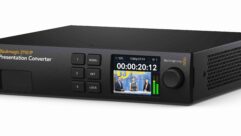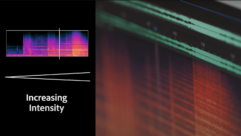

WAYNE, N.J., January 19, 2010 – Fujinon, a major manufacturer and distributor of optics and lens assemblies for the digital cinema, broadcast, and industrial markets, announced today the Advanced Imaging and Visualization Laboratory (AIVL) at the Woods Hole Oceanographic Institution (WHOI) used a Fujinon HA13x4.5 wide angle Premier Series HD zoom lens on a prototype still and HD video camera to capture the first video and still images of a deep-sea volcano actively erupting molten lava on the seafloor.
During a research expedition last May aboard the RV Thomas Thompson, oceanographers from NOAA used Jason, a remotely operated vehicle (ROV) that is part of the National Deep Submergence Facility operated by WHOI, to observe and record the powerful event, which occurred in the South Pacific almost 4,000 feet below the ocean surface. The HD video footage was shown for the first time last month at the American Geophysical Union fall meeting in San Francisco.
A team of scientists led by Dr. Joe Resing, a chemical oceanographer at the University of Washington and NOAA, used the Jason ROV, which was positioned close to the erupting volcano to collect samples of rocks, water, and biological specimens. “We were lucky to have those cameras on the vehicle. They are important to the science,”? said Tim Shank, a WHOI macro-biologist who, along with Maryann Keith, helped operate the camera system. “We use the high def cameras to try to identify species. They allow us to look at the morphology of the animals, some smaller than three or four inches long.”?
The unique camera system was designed and operated by AIVL, which develops high resolution imaging systems for scientific and entertainment imaging applications. Footage from AIVL systems has been used in hundreds of television programs and documentaries, as well as IMAX films.
According to William N. Lange, AIVL research specialist, the camera’s 1-CCD image sensor acquires up to 60 still images per second while simultaneously generating HD video at 29.97 frames per second. The system offers 1920×1080 resolution, producing raw still image data without spatial compression and a 10-bit, 4:2:2 HD-SDI video stream.
“We found a type of lava never before seen erupting from an active volcano, and for the first time observed molten lava flowing across the deep-ocean seafloor,”? said Resing. “In terms of understanding how the volcano is erupting, the high frame rate lets you stop the motion and look to see what is happening. You can see the processes better.”?
The ROV transmitted live HD video of the eruption back to the RV Thomas Thompson through a fiber optic tether. Lange said the system’s Fujinon HD lens provides almost twice the focal length and many times the resolution of the SD cameras that are normally used on vehicles like Jason.
“This camera is a hybrid based around the concept that we need to acquire still and motion imagery from our HD cameras,”? Lange explained. “It’s an architecture we’ve developed to support a variety of image sensors and its modularity allows us to adapt it efficiently for different scientific purposes.”?
Installation of the prototype camera system, which had been used on two previous expeditions, was funded by the National Science Foundation. After its successful tests, Lange said the new camera could become a permanent upgrade on Jason and Alvin, a manned deep-sea submersible, later this year.
“I think it performed very well,”? Lange added. “It did a fantastic job of capturing this unique geological event, and gave the scientists the ability to see details they could not see with standard definition systems.”?
To see video footage of the deep-sea volcanic eruption, please visit:
http://www.whoi.edu/page.do?pid=37675&tid=201&cid=38496&ct=281
.
About Woods Hole Oceanographic Institution
The Woods Hole Oceanographic Institution is a private, independent organization in Falmouth, Mass., dedicated to marine research, engineering, and higher education. Established in 1930 on a recommendation from the National Academy of Sciences, its primary mission is to understand the oceans and their interaction with the Earth as a whole, and to communicate a basic understanding of the ocean’s role in the changing global environment.
The Advanced Imaging and Visualization Laboratory, at WHOI, specializes in the design and development of imaging systems for the acquisition of scientific and educational imagery from the world’s most hostile environments, including those found in the deepest parts of the worlds oceans. For many years, AIVL has been a leader in the development of cinematography quality 2D, 3D, HD and hyper-definition camera systems for both terrestrial and underwater applications. The lab has developed a suite of small, easy to operate underwater stereoscopic 3D camera systems as well as many 3D camera rig designs for use in terrestrial and underwater film making applications. For more information please contact William N. Lange,
.
About Fujinon
Fujinon is a major manufacturer and distributor of optics and lens assemblies for the broadcast, digital cinema and industrial markets. The company’s line of television zoom lenses are used in virtually every segment of the broadcast industry, including electronic newsgathering, studio and field production, and high definition television. For more information about Fujinon broadcast and communications products, call (973) 633-5600 or visit our web site at
.










